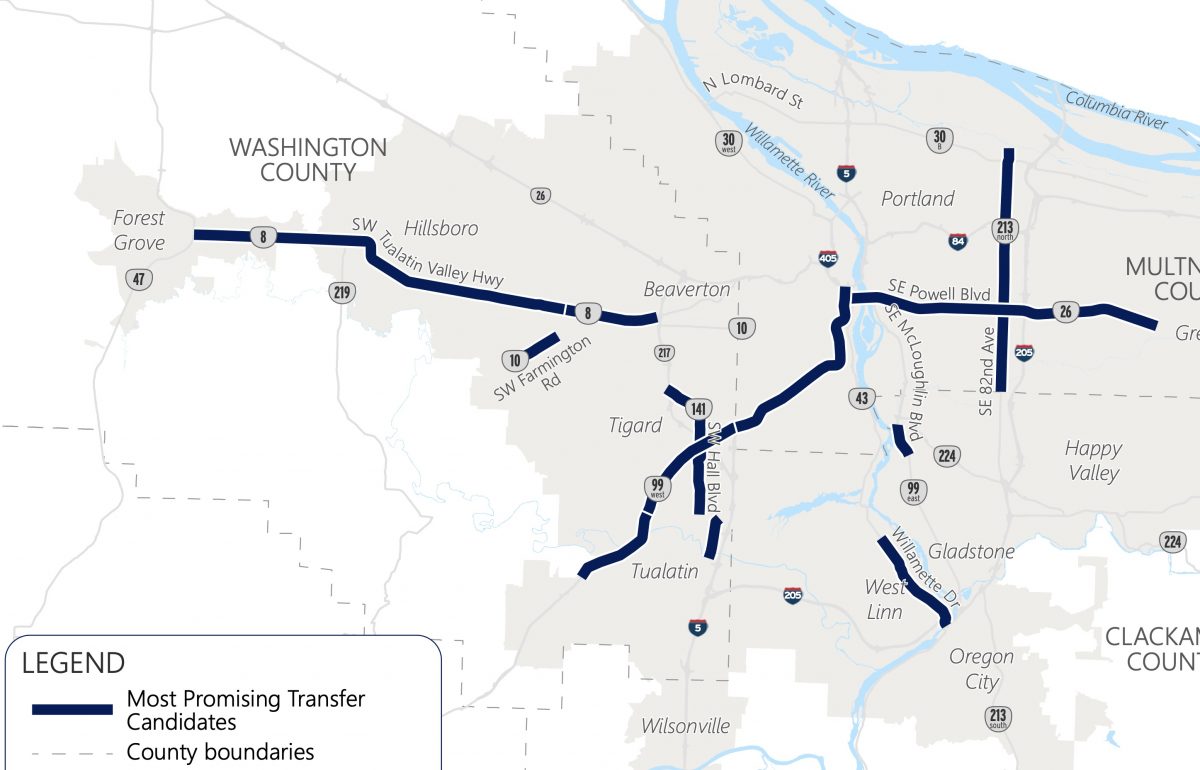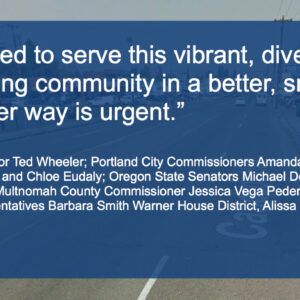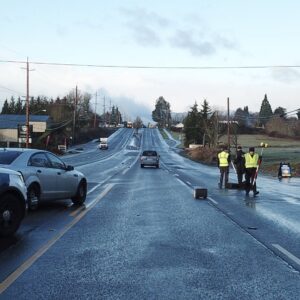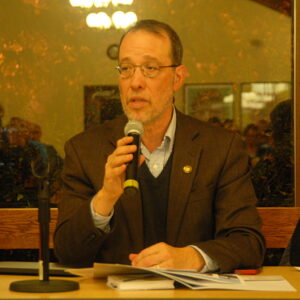
(Photo: Jonathan Maus/BikePortland)
A long-held aspiration of many local transportation planners and advocates has taken a big step forward.
On Tuesday Metro opened a comment period for their draft Regional Framework for Highway Jurisdictional Transfer Study. The study identified a list of 11 state-owned highways that are primed for new management because they’ve been neglected by their current boss — the Oregon Department of Transportation.

(Map: Metro)
These highways — which function more like urban arterials — are relics of a pre-interstate era. They were built to get produce and other items from farms into the central city. When the big, shiny, new freeways were built in the 1950s through 1970s, ODOT walked away from them. They became what are known as “orphan highways” and a cycle of neglect began. As cities and neighborhoods have grown up around them, these highways have fallen out of favor and aren’t prioritized for federal and state funding. In recent decades a wide chasm has formed between the priorities of ODOT, the tragic outcomes of their car-centric street designs, and the daily needs of people who live in communities adjacent to them.
Transferring urban arterials to local jurisdictions would save many lives and allow cities and counties to create healthier streets and neighborhoods.
Below is the list of 11 corridor segments Metro says, “showed the strongest characteristics for potential jurisdictional transfer based on an assessment of technical, readiness and equity considerations”:
1. Powell Boulevard (U.S. 26): MP 0.2 – 10.0
2. Barbur Boulevard (OR 99W): MP 1.2 – 7.6
3. SE/NE 82nd Avenue (OR 213): MP -0.1 – 7.2
4. Tualatin Valley Highway (OR 8): MP 2.9 – 5.9
5. Pacific Highway W (OR 99W): MP 7.6 -11.5
6. Tualatin Valley Highway (OR 8): MP 5.9 – 17.9
7. Pacific Highway W (OR 99W): MP 11.5 – 14.5
8. Farmington Road (OR 10): MP 5.9 – 7.3
9. SW Hall Boulevard (OR 141): MP 2.6 – 7.1 and
MP 7.7 – 8.9
10. SE McLoughlin Boulevard (OR 99E): MP 5.7 – 6.7
11. Willamette Drive (OR 43): MP 8.0 – 11.5
Advertisement
In my years covering this beat I’ve yet to hear anyone who’s against jurisdictional transfer. Even ODOT is eager for it to happen! In 2015 the Governor’s Transportation Vision Panel (which greatly influenced the HB 2017 statewide transportation package) recommended that ODOT form and fund a jurisdictional transfer pilot program. They singled out Powell, 82nd, and Barbur as excellent transfer candidates — all of which are on Metro’s list. State legislators took heed in 2017 and allocated $110 million (starting in 2022) to transfer Southeast Powell Boulevard from ODOT to PBOT.
As the Powell example illustrates, cost is the biggest obstacle to these transfers because local jurisdictions want the road must be brought up to their current standards before making the swap. And there’s all the red tape and technical analysis. That’s where this report comes in. Metro has done a bunch of important leg-work to get these transfers closer to being shovel-ready.
But before you get too excited about what it would mean if, let’s say, the (much more progressive than ODOT) Portland Bureau of Transportation was able to do whatever they please on Barbur or 82nd, keep in mind that this report won’t lead directly to any transfers. If and when they happen, it’ll take just the right mix of political will and funding.
Now is the time to learn about this process and tell Metro what you think about it. The comment period is open until October 22nd.
Here are the links you need:
— Metro jurisdictional transfer report page
— Regional Framework for Highway Jurisdictional Transfer Study (PDF)
— Online survey to share feedback
— Governor’s Transportation Vision Panel jurisdictional transfer overview (PDF)
— Jonathan Maus: (503) 706-8804, @jonathan_maus on Twitter and jonathan@bikeportland.org
— Get our headlines delivered to your inbox.
— Support this independent community media outlet with a one-time contribution or monthly subscription.






Thanks for reading.
BikePortland has served this community with independent community journalism since 2005. We rely on subscriptions from readers like you to survive. Your financial support is vital in keeping this valuable resource alive and well.
Please subscribe today to strengthen and expand our work.
WOW! Thank you METRO for doing this boring but important work!
Ha! That could be Metro’s motto: “We do boring but important work so you don’t have to.”
I would love to see TV Highway and Farmington Road transferred to Beaverton, Washington County, and/or Hillsboro. The City of Beaverton is doing some really forward-thinking things with transit, trying to transform the city center into something walkable/livable, and they have two ODOT highways going right through that they have no control over. This would be a terrific change for these highways. I’m less familiar on the ground with the other locations around metro Portland, but I’m sure the issues are similar. I know this won’t happen overnight, but sooner is better.
I definitely agree with you, but just noting that the portion of Farmington through the downtown area has already been transferred.
Both TV Hwy (#s 4 & 6) and Pacific Hwy W (#s 5 & 7) are repeated in the list of 11. What two are not shown?
It’s just two portions of the same highway that were analyzed separately. So the “11 highways” is slightly misleading, it’s more like 11 highway segments.
Thanks mh,
That’s because there are different segments. I left out the milepost figures for clarity but didn’t realize this confusion would follow. I’ll add them back in now.
Haha of course no Lombard. Sure, it’s just a massive scar that disrupts all forms of non-car traffic in a massive community, but no one from Metro lives up here.
It’s because Highway 30 Bypass is the designated over-dimensional route for freight that can’t use Highway 30 proper. So there’s an extra barrier for that one that would make jurisdictional transfer difficult.
.
Totally, they aren’t willing to do the work because they don’t care about the people who live here
in order to vacate the oversized route, ODOT would need to remove height restrictions on the US 30 truck route on N Columbia Blvd, including replacement of the George MS pedestrian bridge, and the UP freight crossover near I-5. I believe the new NP Willamette Greenway bridge connecting Chimney Park and the SJ Prairie will be built to accomdate oversized freight. The cost of, and the difficulty working with UPRR to accomplish that makes the project aspirational and likely so till the point it MUST be addressed.
The original list has 17 highway links, including Lombard/Sandy (US 30). Metro has for various reasons focused on 11 of those, but the other 6 are still transferable. The comments on freight movement could just as easily be applied to those roadways getting transferred or have already been transferred. It really boils down to politics and money.
Most of these are ‘curb to curb’, meaning the sidewalk is already city owned (like SE Powell), but the roadway is state owned!
On outer Powell, 82nd, and outer Sandy, ODOT owns the entire right of way, sidewalks and all, but not necessarily the sewers and water lines. Not sure about the other road segments listed.
Here in NC where I currently live, the state DOT owns all the highways, arterial and collector roads, but not the sidewalks, sewers, grassy strips, etc. Every state is different.
Here’s clarification on ownership of the right of way re: 82nd Ave cited from the 82nd Avenue Plan with added emphasis on my part.
“Typically, the sidewalks behind the curb are under PBOT ownership between NE Prescott and SE Flavel. ODOT owns the sidewalks north of NE Prescott and south of SE Flavel. PBOT oversees sidewalk maintenance.”
https://www.portlandoregon.gov/transportation/article/730782
The sidewalk sections along Lents and Brentwood-Darlington that are ODOT owned fall short of the standards at ODOT and PBOT (e.g. 82nd Ave & Clatsop).
https://www.google.com/maps/@45.4618359,-122.578972,3a,75y,16.11h,84.71t/data=!3m6!1e1!3m4!1sOFSjki0idL9_wEg-N9YfHw!2e0!7i16384!8i8192
I agree with the comments regarding the varying division of responsibility along these state roadways. At best it’s interesting and more complex than people realize and at worst it’s a significant impediment to making our communities safer, accessible, and accomodating for the people that live there.
I’m sure there’s regular disagreement between PBOT and ODOT staff on who owns what, especially when ODOT repairs curb ramps and sidewalks in “PBOT” areas. The report you accurately cite was written by PBOT. None of this matters much if and when everything gets transferred to PBOT, but until then, I’d expect as much wrangling over 82nd as over SW Barbur or outer Powell, or any other road the two bloated bureaucratic agencies have opportunities to fight over.
As for sidewalk standards, ODOT has a current policy of building sidewalks to local standards when those local standards exceed state standards (such as in Portland, Eugene, etc), as long as they have needed right-of-way and the necessary funding (such as on outer Powell from 122nd to 136th). The poor sidewalks that ODOT built on 82nd or earlier on outer Powell were done when both the city and the county also had lousy or non-existent standards. In many smaller more rural communities, ODOT often builds sidewalks that vastly exceed the local virtually-nonexistent standards.
Down a block across the street from that location is my favorite pinch point on 82nd. Not enough room to ride a bike on the “sidewalk” there. I’m sure they figured nobody would be crazy enough to walk there when they designed it.
https://goo.gl/maps/4RuDwvRsBNYkDkFo6
You have found the bottle-neck on 82nd. The bizarre thing is, that property owner really does own the land right up to that portion of sidewalk. I kid you not. And both ODOT and PBOT already know difficult it is going to be to wrest that tiny strip of land from the owner – they’ve tried it before with eminent domain back when it was popular and easy to enforce (unlike now.)
Inner Powell (from an ODOT study): “The segment of Powell Boulevard between SE 9th Avenue and SE 86th Avenue is currently a state highway over a city street. ODOT maintains the roadway from curb-to-curb, and the City maintains the landscaped medians and area outside of the curb line, such as sidewalks. The segment from SE 86th Avenue to I-205 is a State Fee Simple right-of-way, which is owned, controlled, and maintained by the State, except certain elements for which there are maintenance agreements between ODOT and the City (refer to Misc. Contracts and Agreement No. 7219 – Construction Finance Agreement Interstate Transfer Project, executed in 1980).”
Hall Boulevard! Yes please! It has a bike lane already, but the speed limit is high given the number of driveways and side streets, and the bike lanes disappear periodically when Hall goes over 217, forcing cyclists to merge with fast traffic.
Its so strange how its a pretty nice ride going NW to SE across central Beaverton but near impossible to do the opposite.
Not mentioned is about 1/4 of the list will be “resolved” if (IF?) voters approve Metro’s Transportation Measure on the ballot in November as it funds SW Corridor light rail and the associated “improvements”.
Yep, yep. I had the same thoughts reading this latest study and recalling the corridors with proposed investments in the T2020 bond measure.
https://www.oregonmetro.gov/sites/default/files/2020/07/20/Resolution-20-5122-GetMoving2020-Corridor-Investments-20200716.pdf
I’d like to see even more transfers. ODOT’s priorities for their roads (maximizing speed and volume of vehicles moved through) are so out of line with what a successful urban city needs them to be.
ODOT might make a road diet on SW Canyon Road between near 87th Ave to near Raab Road/Canyon Lane. ODOT has thought about this for the 2024 repave of Canyon in West Slope.
Honestly I think a road diet all the way from 217 to 26 would be feasible. I’ve never seen car traffic volumes there justifying two lanes each direction; through car traffic can easily take the route on the freeways. Just turn the outside lane in each direction into a protected bike lane; easy. Particularly the part west of Canyon Drive is currently a huge gap in the bike network and this would be a vital route.
West of 217 it’s a whole different ball game with much more car traffic.
The current cross-section is overkill and just encourages dangerous driving. There may be an argument for a passing lane in the uphill direction, but I think the road would be much safer with a turn lane, one lane in each direction, and bike lanes between 217 and 26.
Absolutely. Having a safe bike route between Sylvan and Beaverton that doesn’t go miles out of the way would be a godsend (getting from the Highway 26 path to downtown Beaverton is surprisingly difficult). This may be wishful thinking on my part, but I hope they could also make 107th Avenue a dedicated bike route and close it to through car traffic, to connect to 5th Street through the parking lot south of Beaverton-Hillsdale. This would finally form a direct route from downtown Portland all the way to Beaverton without having to go miles out of the way.
If Powell was transferred, does that mean Metro (or the City of Portland, or Multnomah County) would get the Ross Island Bridge?
Anything is possible. The Powell Boulevard section in the study that was recommended for further discussions starts at mile post 0.2, which is to the west of the bridge. So the bridge is included in the study (which was done by consultant WSP USA fyi for Metro and ODOT as supporting agency). You should make the comment in support of including the bridge during this public comment period if you do support it, Doug.
Additional thought: It wouldn’t be Metro. It would be the City of Portland or, since Multnomah County oversees so many bridges, possibly the county.
Almost definitely the county, part of a 1992 service agreement between the jurisdictions.
Hopefully they expedite light rail on Powell. Unlike Barbur, that’s a corridor where it really makes sense.
I love this post and photo from VintagePortland depicting mothers on Powell protecting students from traffic in 1950. Seems like we as citizens of this city have wanted Powell to be better for at least a few(70) years now. Anyhow, this is good news, I hope we can get some of these urban highways transferred one day.
href=”https://vintageportland.wordpress.com/2015/03/03/se-powell-blvd-circa-1950/”>
Nov 27th 1958 apparently, SE Powell at about 50th & Foster, in the late afternoon, about tea time. Thank you for the link.
ODOT definition of an orphan highway:
4.2 Orphan Highways
“Orphan highways” are district and regional state highways that are owned by ODOT, but functionally serve as city streets or county roads. This may be due to changes in surrounding land uses or the transportation network that result in longer-distance regional trips shifting to nearby interstates or other highways. While ODOT can transfer control of state highways to cities or counties, the roadways must first be brought to a state of good repair and meet current design standards. The cost to do so is a major hurdle to jurisdictional transfers.